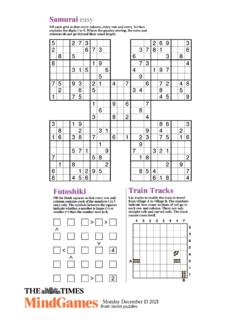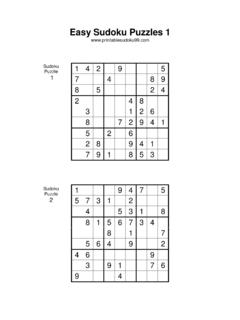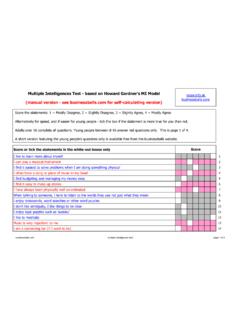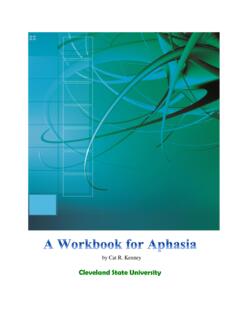Transcription of SUDOKU SOLVING TIPS - Penny Dell Puzzles
1 Copyright 2008 Penny Publications, STARTEDTo solve a regular SUDOKU puzzle, place a number intoeach cell of the diagram so that each row across, each col-umn down, and each block within the larger diagram(there are 9 of these) will contain every number from 1through 9. In other words, no number may appear morethan once in any row, column, or block. Working with theseeds already given as a guide, complete each puzzle withthe missing numbers that will lead to the correct example, look at the ninth column of the example puz-zle to the right. There are clues in the puzzle that will tellyou where, in this column, the number 3 first clue lies in the eighth column of the is a 3 in the fifth cell. Since numbers can't berepeated in any 3 x 3 block, we can't put a 3 in the fourth,fifth, or sixth cells of the ninth can also eliminate the bottom three cells of the ninthcolumn because there's a 3 in that 3 x 3 block as , the 3 must go in the second or third cell of theninth final clue lies in the second row of the diagram, whichalready has a 3 in it.
2 Since numbers can't be repeatedwithin a row, there's only one cell left for the 3 the third cell of the ninth basic elimination process used in the example aboveresults in a Direct Solve. The best way to work through aSudoku puzzle is to tackle the Direct Solves first, sincethey are the easiest. In fact, all easy -level Puzzles can becompleted using only Direct more difficult SUDOKU Puzzles , you will reach a pointat which Direct Solves no longer exist. At this stage, youneed to review the possible candidates for each cell, andthen start looking at the relationships among cells to seewhat candidates you can eliminate. This will eventuallyreveal the next solvable the candidates to eliminate is where advanced SOLVING techniques called Deductions come are 8 different deductive techniques that SudokuSolver will point out for you when they are is a description of each, in order of their complexity.
3 Please note that applying deductions will oftenresult in Indirect Solves. Indirect Solves are similar to Direct Solves, except that some of the candidates willhave been eliminated via deductions, rather than directly from the solved SOLVING TIPSTM2345678912356789123567891236781223 4567891234567891234567891234567891234567 891234567891234567891234567891234567891 Terms you will need to knowBlock:One of the nine 3x3 sections that make up the SUDOKU (s):The possible numbers that could be in a :A single square in a SUDOKU 2008 Penny Publications, CANDIDATEIn a locked candidate, a value must appear at the inter-section of a particular block and row or column, and cantherefore be removed as a candidate from the rest ofthat block and row or column. In the example at right,we've filled in the candidates for each cell, and the 6 inRow A can only be in Block 2 (in other words, none ofthe cells in Row A in either Block 1 or Block 3 have 6 asa candidate).
4 Therefore, 6 can be eliminated as a candi-date from all other cells in Block 2 that is, the 6 canbe eliminated from PAIRIn a naked pair, two cells in a row, column, or block eachcontain the same two candidates, and only those candi-dates. If a naked pair appears in a row, column, orblock, those two candidates can be eliminated fromevery other cell in that row, column, or block. In theexample at right, we've filled in the candidates for eachcell, and the only possible candidates for cells I1 and I7are 2 and 8, forming a naked pair. Since 2 and 8 mustbe in cells I1 and I7, in some order, none of the othercells in row I can be either a 2 or an 8 (or we could notgive values to both I1 and I7). Therefore, 2 and 8 can beeliminated from all other cells in row I that is, the 2can be eliminated from I3, 2 and 8 can be eliminatedfrom I8, and 8 can be eliminated from 2008 Penny Publications, 4 6845858958917957157 NAKED TRIPLETThe naked triplet is similar to the naked pair, but itinvolves three cells instead of two.
5 In the example atright, cell G7 is 3 or 7; cell G9 is 1, 3, or 7; and cell I9 is1 or 3, so in that block, 1, 3, and 7 must be in cells G7,G9, and I9, in some order. Therefore, 1, 3, and 7 can beeliminated from all other cells in that block. With anaked triplet, some (or all) of the three cells in questionmay have only 2 out of the 3 candidates, as in our PAIRIn a hidden pair, two numbers are candidates for twodifferent cells in a row, column, or block, and in no othercells in that row, column, or block, even if the two cellsin question have other possible candidates. The otherpossible candidates can then be eliminated from thosecells, since those two numbers have to be in those cells(or they wouldn't appear in the row, column, or block).In the example at right, the only cells in row I that con-tain the candidates 1 and 7 are I3 and I8, so 1 and 7must be in I3 and I8 in some order, so all other candi-dates in those two cells can be 2008 Penny Publications, 8936366719689126891781783912637788919383 78278193838237867191 ABCDEFGHI2345678923456789123456789134567 89134567934569454519289359258912 121262678 7816281269127816791781478147867868131678 1289232918923782584824823723782782792323 6715671229X-WINGAn X-Wing takes into account the interaction betweentwo different rows and columns.
6 If a value in one rowcan only appear in two different cells, and that samevalue in another row can only appear in two differentcells, and those four cells are in the same two columns,that value must appear in one of those cells in each ofthe two columns, and therefore can be eliminated fromany other cell in the two columns. (The same theoryworks if you swap rows and columns.) In the example atright, the 9 in column 1 can only be in row E or row G,and the 9 in column 7 also can only be in row E or rowG. If the 9 in column 1 is in row E, the 9 in column 7must therefore be in row G, and if the 9 in column 1 isin row G, the 9 in column 7 must therefore be in row , the 9 cannot be in any other cells in rows Eand G but E1, E7, G1, or G7 (or we would not be able toplace the 9s in columns 1 and 7), so we can eliminatethe 9s from all other cells in those two TRIPLETThe hidden triplet is similar to the hidden pair, but itinvolves three cells instead of two.
7 In the example atright, the only cells in column 6 that contain the candi-dates 1, 2, or 7 are A6, D6, and I6, so 1, 2, and 7 mustbe in A6, D6, and I6 in some order, so all other candi-dates in those three cells can be 2008 Penny Publications, XY-Wing is a relationship that occurs among threecells that form an angle, where each of the three cellshas only two values in it. If the stem of the angle (we'llcall it cell A) has the only possible candidates x and y,and the other two cells the branches of the angle (we'll call them cells B and C) have the only possiblecandidates x or z and y or z in some order, no cell thatinteracts with both of those cells can have the candi-date z. If it did, then cells B and C would have the val-ues x and y, in some order, leaving no possible value forcell A.
8 An XY-Wing can appear in two ways with aright angle and without a right Y-WING (With a Right Angle)In this type of XY-Wing, the three cells form a rightangle. In the example at right, cell B1 (the stem of theright angle) is 4 or 9, cell B5 is 1 or 9, and cell D1 is 1or 4. If cell D5 were 1, then B5 would have to be 9 andD1 would have to be 4, leaving no possible value for B1;therefore, 1 can be eliminated from cell 2008 Penny Publications, (Without a Right Angle)In this type of XY-Wing, the three cells in question stillform an angle, but it is not a right angle. In the exam-ple at right, cell I6 (the stem of the angle) is 4 or 7, cellH5 is 4 or 5, and cell I2 is 5 or 7. If cell H2 were 5, thenH5 would have to be 4 and I2 would have to be 7, leav-ing no possible value for I6; therefore, 5 can be eliminat-ed from cell is similar to X-Wing, but it takes intoaccount the interaction among three different cells andcolumns.
9 If a value can only be in two or three of threedifferent cells in each of three rows, and all three ofthose cells are in the same columns in all three rows,that value must appear in one of those cells in each ofthe three columns, and therefore can be eliminatedfrom any other cell in the three columns. In the exam-ple at right, the 2 in row A can only be in column 6 orcolumn 9, the 2 in row E can only be in column 1 or col-umn 9, and the 2 in row I can only be in column 1 or col-umn 6. If the 2 in row A is in A9, the 2 in row E mustbe in E1, and the 2 in row I must be in I6; and if the 2in row A is in A6, the 2 in row I must be in I1, and the2 in row E must be in E9. A 2 cannot therefore be in anyother cells in columns 1, 6, or 9 but A6, A9, E1, E9, I1,and I6 (or we would not be able to place the 2s in rowsA, E, and I), so we can eliminate the 2s from all othercells in those three 9782782371624122462371279234781471791579 78 7891916712712791791679679139274791491747 8 ABCDEFGHI234567891 ABCDEFGHI2345678923456789134567891234567 8912345678912345678134567891356891884547 6745675724292924242413919391272712363759 2926





